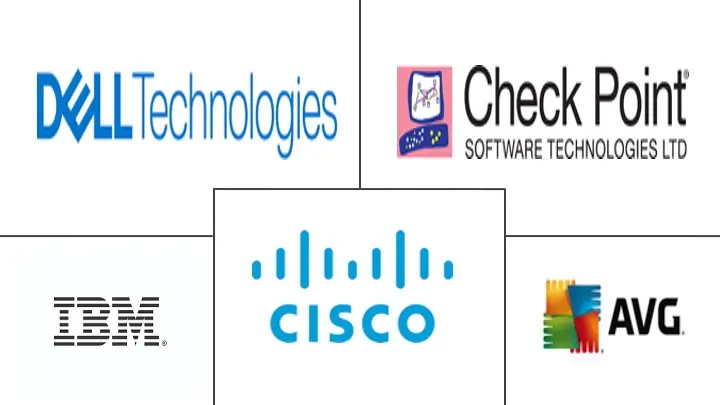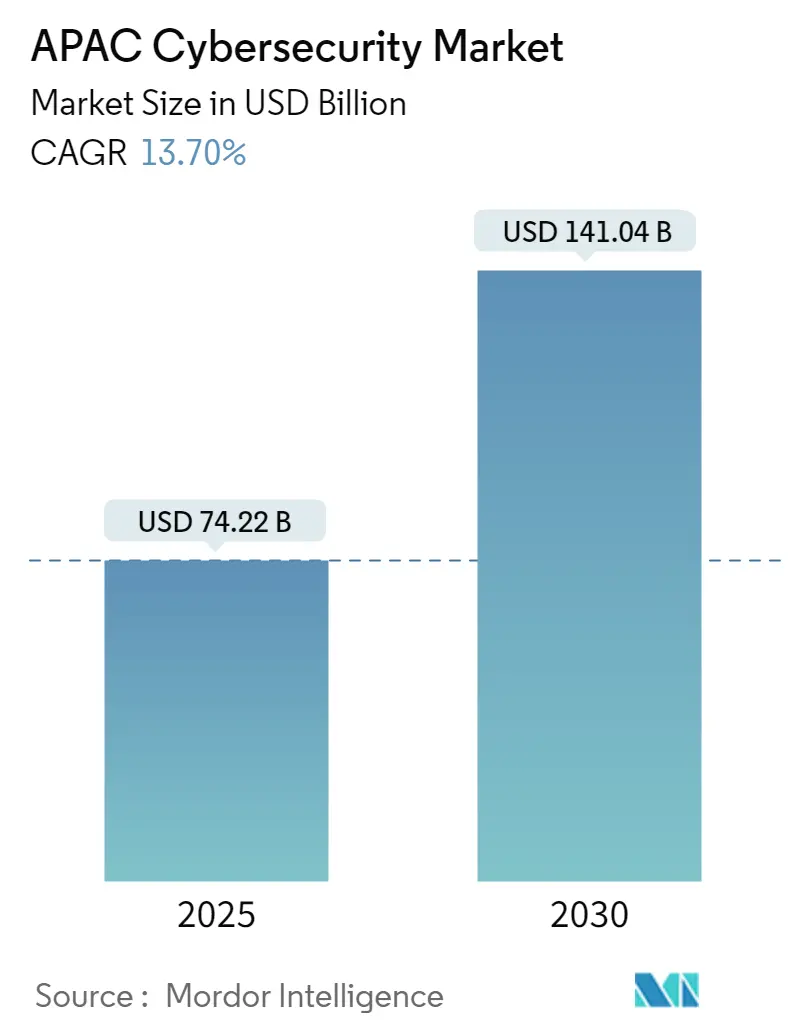
APAC Cybersecurity Market Analysis by Mordor Intelligence
The APAC cybersecurity market size reached USD 74.22 billion in 2025 and is forecast to expand at a 13.7% CAGR to USD 141.04 billion by 2030, reflecting governments’ push for digital sovereignty and enterprises’ shift toward proactive cyber-defense models. Heightened state-sponsored attacks, accelerating 5G roll-outs, surging digital-payment fraud, and chronic talent shortages are reshaping budget priorities, while local data-protection rules are recasting procurement in favor of regionally domiciled vendors. Competition now hinges less on product features and more on the ability to deliver sovereign-cloud architectures, AI-driven managed detection, and integrated IT-OT security across fragmented regulatory environments. Opportunities abound for providers that combine localized threat intelligence with scalable managed services, especially in mid-market segments underserved by in-house security expertise.
Key Report Takeaways
- By offering, solutions led with 57.6% revenue in 2024, but managed services are projected to grow at 21.4% CAGR through 2030.
- By deployment mode, on-premise held 62.5% of APAC cybersecurity market share in 2024, while cloud-based security is set to climb at 23.5% CAGR to 2030.
- By end-user vertical, BFSI captured 24.8% share of the APAC cybersecurity market size in 2024; healthcare is the fastest-growing vertical at 20.1% CAGR.
- By enterprise size, large organizations controlled 67.2% revenue in 2024, whereas SMEs will expand at 19% CAGR through 2030.
- By country, China commanded 44.7% market share in 2024; India is the fastest-growing geography at 24.2% CAGR to 2030.
APAC Cybersecurity Market Trends and Insights
Drivers Impact Analysis
| Driver | (~) % Impact on CAGR Forecast | Geographic Relevance | Impact Timeline |
|---|---|---|---|
| Government Data-Sovereignty Mandates Accelerating Domestic Cybersecurity Spend | +2.8% | China, India, Singapore, Australia | Medium term (2-4 years) |
| 5G Roll-Outs Creating New Network Threat Surfaces for Telcos | +2.1% | Japan, South Korea, India, Australia | Short term (≤ 2 years) |
| Surge in Digital Payments & E-commerce Fraud Driving Security Investments | +1.9% | Southeast Asia, India, China | Short term (≤ 2 years) |
| Escalating State-Sponsored Attacks on Critical Infrastructure | +2.4% | Global APAC, concentrated in Japan, Australia, Taiwan | Long term (≥ 4 years) |
| SME Cloud Migration Wave Necessitating Cloud Workload Protection | +1.7% | China, ASEAN, India | Medium term (2-4 years) |
| National Cybersecurity Incentive Programs Catalyzing Market Growth | +1.6% | Singapore, Australia, Japan, South Korea | Medium term (2-4 years) |
| Source: Mordor Intelligence | |||
Government Data-Sovereignty Mandates Accelerating Domestic Cybersecurity Spend Across APAC
China’s Network Data Security Management Regulations taking effect in 2025 require in-country data processing and create separate security stacks for multinationals operating inside China[1]Graham Smith, “China’s New Network Data Security Rules Explained,” Bird & Bird, twobirds.com. Singapore’s refreshed Cyber Essentials program ties government contracts to vendor certification, driving local provider demand. Australia’s REDSPICE initiative allocates AUD 2 billion to a sovereign cloud for the intelligence community, illustrating how policy translates directly into cybersecurity outlays. Vendors now localize R&D centers and SOCs to preserve market access, while homegrown specialists gain a compliance-driven edge.
5G Roll-Outs Creating New Network Threat Surfaces for Telcos in Japan, South Korea and India
High-throughput 5G architectures introduce micro-slicing and edge-compute nodes that traditional perimeter tools cannot secure. Japan’s Active Cyber Defense law authorizes pre-emptive disruption of cyber threats targeting telecom networks. South Korea logged 1.56 million hacking attempts on public networks in 2024, 80% aimed at 5G and IoT endpoints. India’s operators report that 57% of breaches result in service slowdowns, highlighting the urgency for zero-trust and AI-driven analytics. Consequently, demand is rising for secure access service edge (SASE) platforms and virtualized firewalls optimized for carrier environments.
Surge in Digital-Payment and E-Commerce Fraud Driving Security Investments in Southeast Asia
Cashless transactions soared to USD 9.8 trillion globally in 2024, and Southeast Asia’s super-app ecosystems have become prime targets for credential-stuffing and account-takeover fraud. Vietnam’s cybersecurity market is projected to hit USD 511 million by 2029, fueled largely by payment-security spend. The Philippines boosted its cybersecurity budget by 49.2% to PHP 7.8 billion (USD 140 million) after agencies recorded 8,800 daily cyber incidents. Banks and fintech firms now deploy real-time behavioral analytics and biometric authentication to curb fraud without increasing false positives.
Escalating State-Sponsored Attacks on APAC Critical Infrastructure Stimulating OT Security Adoption
Campaigns such as Volt Typhoon, attributed to Chinese state actors, underscore attackers’ interest in disabling utilities and logistics networks during crises. Microsoft observed 600 million hostile probes per day on cloud customers in 2024, with nation-state groups blending espionage and financial motives. Taiwan’s drone supply chain endured coordinated malware implants that traversed from suppliers into defense production lines. Operators respond by segmenting OT networks, installing one-way diodes, and subscribing to specialized threat-intel feeds that map adversary infrastructure.
Restraint Impact Analysis
| Restraint | (~) % Impact on CAGR Forecast | Geographic Relevance | Impact Timeline |
|---|---|---|---|
| Acute Cybersecurity Talent Shortage Inflating Service Costs | -2.3% | Emerging APAC economies, particularly Philippines, Vietnam, India | Long term (≥ 4 years) |
| Fragmented Regional Compliance Regimes Complicating Solution Standardization | -1.8% | Global APAC, most severe in cross-border operations | Medium term (2-4 years) |
| High Price Sensitivity Among APAC SMEs Limiting Adoption of Advanced Solutions | -1.4% | Southeast Asia, India, emerging APAC markets | Medium term (2-4 years) |
| Supply-Chain Disruptions from Export Controls on Security Hardware Components | -1.1% | China, North Korea-affected regions, semiconductor-dependent markets | Short term (≤ 2 years) |
| Source: Mordor Intelligence | |||
Acute Cybersecurity Talent Shortage Inflating Service Costs in Emerging APAC Economies
The region accounts for 2.8 million unfilled cyber roles, restricting managed-service scalability and pushing salaries beyond SME budgets. The Philippines counts only 200 certified specialists versus Singapore’s 3,000, amplifying project delays. Vietnam earmarked USD 100 million for workforce programs to train 1,000 experts and 5,000 engineers by 2025. Scarcity is most severe in OT security and cloud architecture, forcing enterprises to outsource functions or postpone deployments, dampening addressable demand.
Fragmented Regional Compliance Regimes Complicating Solution Standardization
China’s Personal Information Protection Law bans “legitimate interest” as a processing ground, while Singapore mandates local data-privacy representatives and ID-card safeguards. South Korea enforces 24-hour breach notifications, contrasting with Japan’s plan for a cybersecurity rating system under METI. Australia’s five-function cybersecurity framework and India’s Digital Personal Data Protection Act introduce distinct encryption and audit rules[3]Australian Government, “2025–2030 Cybersecurity Strategy—Public Draft,” homeaffairs.gov.au . Vendors must customize roadmaps for each jurisdiction, raising R&D and compliance overhead and slowing multi-market launches.
Segment Analysis
By Offering: Managed Services Surge Amid Skills Crisis
Solutions retained 57.6% revenue in 2024, yet managed security services are projected to expand 21.4% CAGR through 2030 as enterprises confront staffing gaps. The APAC cybersecurity market favors providers that bundle 24×7 SOC monitoring, threat hunting, and incident response under outcome-based SLAs. Ensign InfoSecurity became the only APAC firm to reach the global top-10 MSSP list in 2024, signaling the region’s ascent in managed-service maturity[2]Ensign InfoSecurity, “MSSP Alert Top 250, 2024,” ensigninfosecurity.com.
Rising wages for in-house analysts, coupled with board-level accountability for breaches, push even large enterprises to co-manage security tools with external SOCs. AI-assisted triage and automation enable MSSPs to serve mid-market clients profitably, widening adoption. As a result, investment in platform-based service delivery is accelerating, with providers embedding XDR, SOAR, and machine-learning analytics to differentiate.
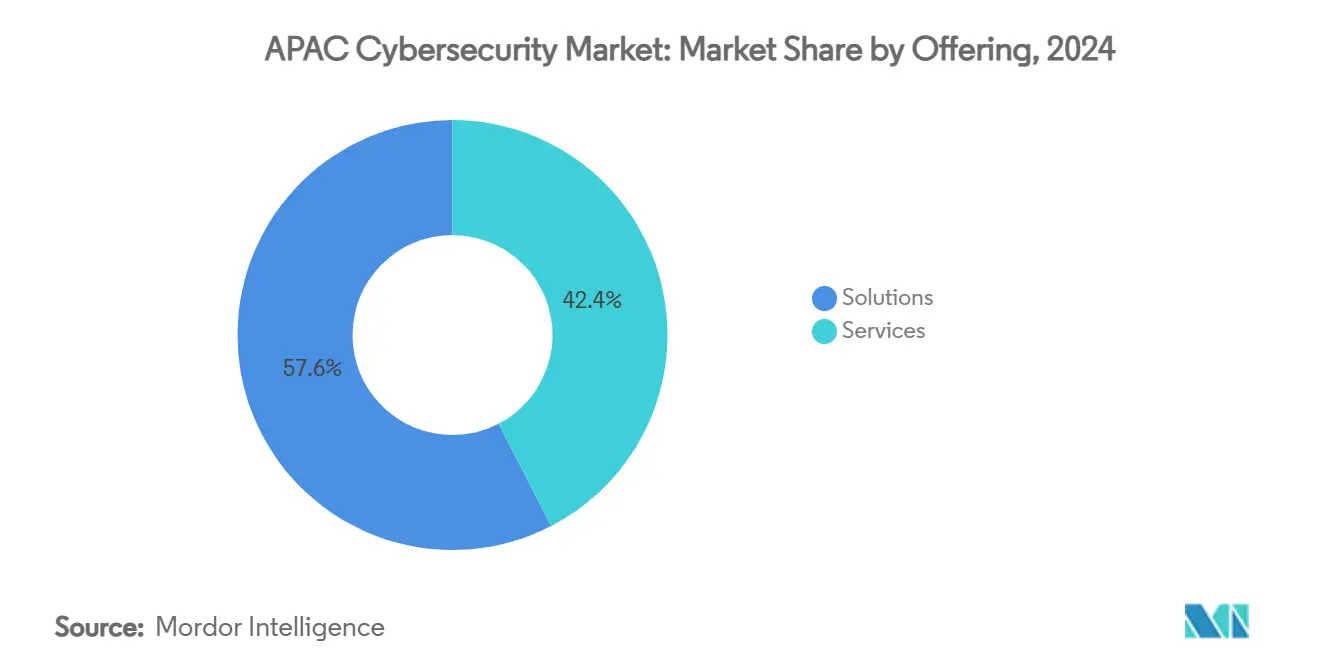
By Deployment Mode: Cloud Transformation Accelerates Despite Legacy Concerns
On-premise installations held 62.5% of APAC cybersecurity market share in 2024 because regulated sectors still favor physical control over data. Cloud-native security, however, is growing at 23.5% CAGR, propelled by remote-work mandates and multi-cloud adoption. A HashiCorp survey showed 70% of regional firms hit business targets via multi-cloud, with 90% rating security the defining success factor.
Organizations are embracing zero-trust networking and container security to protect workloads that span CSPs and edge nodes. Skills shortages remain a headwind—31% cite limited cloud expertise—but vendors counter with low-code policy orchestration and managed SASE offerings. Consequently, cloud deployments increasingly win green-field projects, while hybrid architectures emerge as a transition path for legacy systems.
By End-User Vertical: Healthcare Emerges as Digital Defense Priority
BFSI claimed 24.8% of the APAC cybersecurity market size in 2024, sustained by strict regulatory audits and high transaction volumes. Healthcare, though smaller, is forecast to climb at 20.1% CAGR as telemedicine and electronic-health-record roll-outs expose patient data to ransomware. DNSE Securities recently adopted AI-driven managed detection to protect its trading platform, illustrating cross-vertical demand for real-time monitoring.
Hospitals prioritize segmentation of medical-device networks and user-behavior analytics to detect lateral movement early. Manufacturing and energy utilities accelerate OT security outlays to avoid production stoppages, while retail/e-commerce platforms harden fraud-prevention stacks ahead of peak shopping seasons. Defense industries channel budgets toward air-gapped systems and classified-cloud environments.
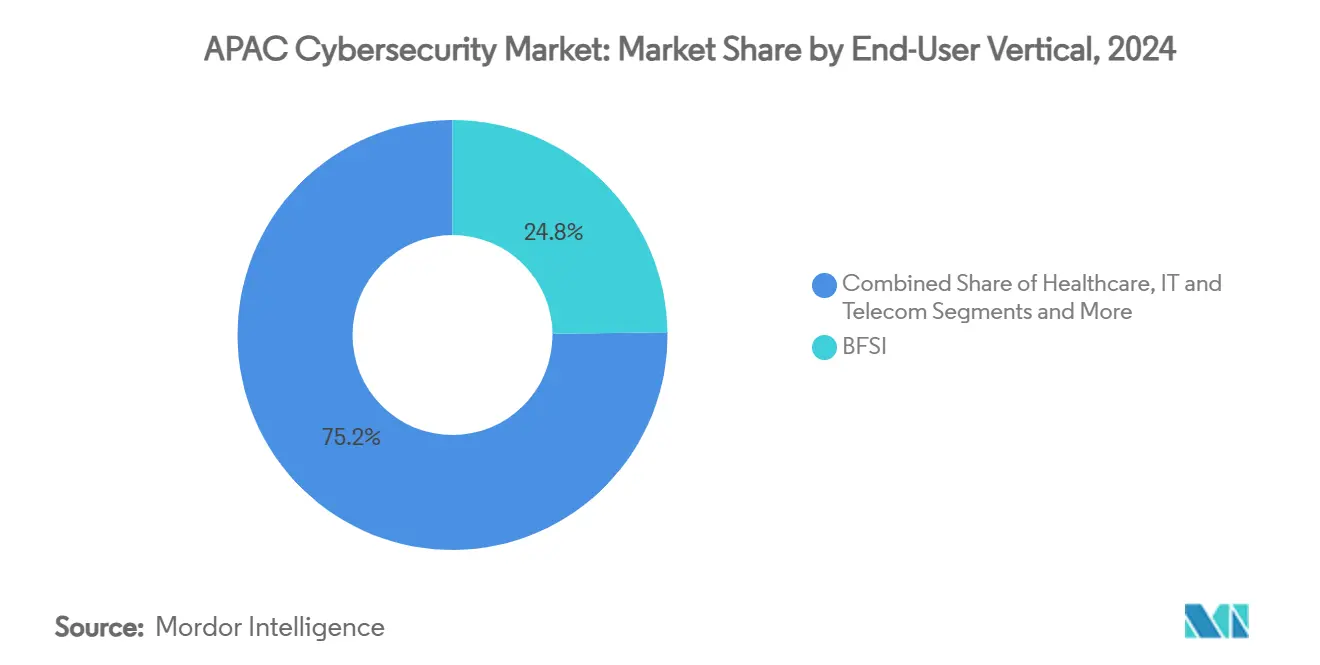
Note: Segment shares of all individual segments available upon report purchase
By End-User Enterprise Size: SME Adoption Accelerates Through Cloud Security
Large enterprises represented 67.2% revenue in 2024, yet SMEs are growing at 19% CAGR as pay-as-you-go cloud security lowers entry barriers. Singapore’s Cyber Essentials grants reimburse up to SGD 15,000 per SME for endpoint protection, email security, and vulnerability assessment tools. The ASEAN Cybersecurity Cooperation Strategy promotes supplier-certification schemes that cascade security requirements down regional value chains.
Vendors tailor “lite” MDR offerings that integrate with SaaS productivity suites, enabling lean IT teams to achieve compliance quickly. Large enterprises, meanwhile, invest in consolidated platforms to rationalize tool sprawl and automate reporting for regulators and insurers.
Geography Analysis
China’s 44.7% revenue share stems from expansive industrial internet projects, smart-city roll-outs, and laws that require in-country data storage. Foreign vendors build separate SOCs inside joint ventures to retain contracts, while local specialists scale AI-enabled analytics tuned to Mandarin language logs. Semiconductor export controls accelerate indigenous hardware and crypto-algorithm development, reinforcing national cyber-sovereignty goals.
India is the fastest-growing contributor to the APAC cybersecurity market, rising at 24.2% CAGR as public-sector cloud adoption and fintech expansion broaden the attack surface. The Joint Doctrine for Cyberspace Operations centralizes military cyber capabilities, and new breach-notification rules compel enterprises to invest in automated incident-response platforms. Government-sponsored skilling programs aim to mitigate the 500,000-person talent gap but will take several years to close.
Japan, South Korea, Australia, and Singapore form a mature security cluster with stringent regulations and high outbound cyber-export capacity. Japan’s Active Cyber Defense law allows authorities to disrupt command-and-control servers preemptively, creating demand for advanced attribution tooling. South Korea’s National Cybersecurity Strategy adopts zero-trust across ministries and subsidizes quantum-safe cryptography pilots. Australia’s REDSPICE program triples offensive cyber capability and funds a Top Secret Cloud on AWS, positioning Canberra as a regional security anchor. Singapore serves as the regional SOC hub, supported by an innovation-friendly policy regime and workforce grants. The rest of Asia Pacific—which includes Vietnam, Thailand, Malaysia, Indonesia, and the Philippines—accounts for a growing slice of the APAC cybersecurity market as digital-payments adoption, 5G deployment, and e-government initiatives outpace legacy controls. Budget constraints and talent shortages steer many organizations toward cloud-delivered security and shared managed-service models backed by local telcos.
Competitive Landscape
China’s 44.7% revenue share stems from expansive industrial internet projects, smart-city roll-outs, and laws that require in-country data storage. Foreign vendors build separate SOCs inside joint ventures to retain contracts, while local specialists scale AI-enabled analytics tuned to Mandarin language logs. Semiconductor export controls accelerate indigenous hardware and crypto-algorithm development, reinforcing national cyber-sovereignty goals.
India is the fastest-growing contributor to the APAC cybersecurity market, rising at 24.2% CAGR as public-sector cloud adoption and fintech expansion broaden the attack surface. The Joint Doctrine for Cyberspace Operations centralizes military cyber capabilities, and new breach-notification rules compel enterprises to invest in automated incident-response platforms. Government-sponsored skilling programs aim to mitigate the 500,000-person talent gap but will take several years to close.
Japan, South Korea, Australia, and Singapore form a mature security cluster with stringent regulations and high outbound cyber-export capacity. Japan’s Active Cyber Defense law allows authorities to disrupt command-and-control servers preemptively, creating demand for advanced attribution tooling. South Korea’s National Cybersecurity Strategy adopts zero-trust across ministries and subsidizes quantum-safe cryptography pilots. Australia’s REDSPICE program triples offensive cyber capability and funds a Top Secret Cloud on AWS, positioning Canberra as a regional security anchor. Singapore serves as the regional SOC hub, supported by an innovation-friendly policy regime and workforce grants.
The rest of Asia Pacific—which includes Vietnam, Thailand, Malaysia, Indonesia, and the Philippines—accounts for a growing slice of the APAC cybersecurity market as digital-payments adoption, 5G deployment, and e-government initiatives outpace legacy controls. Budget constraints and talent shortages steer many organizations toward cloud-delivered security and shared managed-service models backed by local telcos.
APAC Cybersecurity Industry Leaders
-
AVG Technologies (Avast Software s.r.o.)
-
IBM Corporation
-
Check Point Software Technologies Ltd
-
Cisco Systems Inc.
-
Dell Technologies Inc.
- *Disclaimer: Major Players sorted in no particular order
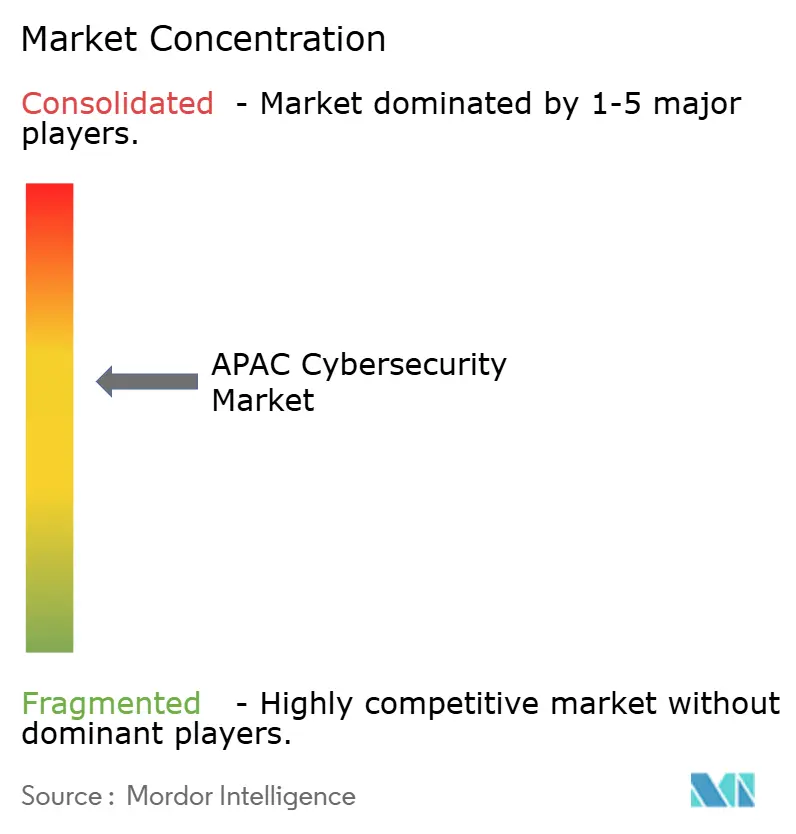
Recent Industry Developments
- July 2025: Australia announced a AUD 2 billion Top Secret Cloud partnership with Amazon Web Services under the REDSPICE program, projected to create 2,000 local jobs.
- May 2025: Japan’s Cabinet enacted Active Cyber Defense legislation empowering pre-emptive disruption of cyber threats against critical networks.
- April 2025: China’s Cyberspace Administration released enhanced Network Data Security Management Regulations effective Jan 2025, tightening cross-border data-transfer rules.
- April 2025: NTT DATA signed an MoU with Singapore’s Cyber Security Agency and committed USD 10 million to talent development.
APAC Cybersecurity Market Report Scope
IT advancements, communication technologies, and smart energy grids are transforming the landscapes of nearly every country's essential infrastructure and commercial networks. Rapidly changing technology, however, brings with it rapidly advancing hazards. Cybersecurity solutions assist a company in monitoring, detecting, reporting, and countering cyber threats, which include internet-based attempts to damage or disrupt information systems and hack crucial data using spyware and malware, as well as phishing to protect data confidentiality. The study's market size is based on end-user spending on cybersecurity systems and services.
The APAC cyber security market is segmented by offerings (solutions [application security, cloud security, data security, identity access management, infrastructure protection, integrated risk management, network security, end-point security, and other solution types] and services [professional services and managed services]), by deployment (On-premise, and cloud), by organization size (SMEs, large enterprises), by end-user vertical (BFSI, healthcare, IT and telecom, industrial and defense, retail, energy and utilities, manufacturing, and other end-user industries), and by country (China, India, Japan, Philippines, South Korea, Australia, Indonesia, Thailand, Malaysia, Rest of APAC). The market sizes and forecasts are provided in terms of value (USD) for all the above segments.
| Solutions | Application Security |
| Cloud Security | |
| Data Security | |
| Identity and Access Management | |
| Infrastructure Protection | |
| Integrated Risk Management | |
| Network Security Equipment | |
| Endpoint Security | |
| Other Services | |
| Services | Professional Services |
| Managed Services |
| On-Premise |
| Cloud |
| BFSI |
| Healthcare |
| IT and Telecom |
| Industrial and Defense |
| Manufacturing |
| Retail and E-commerce |
| Energy and Utilities |
| Manufacturing |
| Others |
| Small and Medium Enterprises (SMEs) |
| Large Enterprises |
| China |
| Japan |
| India |
| South Korea |
| Australia and New Zealand |
| Singapore |
| Rest of Asia Pacific |
| By Offering | Solutions | Application Security |
| Cloud Security | ||
| Data Security | ||
| Identity and Access Management | ||
| Infrastructure Protection | ||
| Integrated Risk Management | ||
| Network Security Equipment | ||
| Endpoint Security | ||
| Other Services | ||
| Services | Professional Services | |
| Managed Services | ||
| By Deployment Mode | On-Premise | |
| Cloud | ||
| By End-User Vertical | BFSI | |
| Healthcare | ||
| IT and Telecom | ||
| Industrial and Defense | ||
| Manufacturing | ||
| Retail and E-commerce | ||
| Energy and Utilities | ||
| Manufacturing | ||
| Others | ||
| By End-User Enterprise Size | Small and Medium Enterprises (SMEs) | |
| Large Enterprises | ||
| By Country | China | |
| Japan | ||
| India | ||
| South Korea | ||
| Australia and New Zealand | ||
| Singapore | ||
| Rest of Asia Pacific | ||
Key Questions Answered in the Report
What is the current size of the APAC cybersecurity market?
The APAC cybersecurity market size reached USD 74.22 billion in 2025 and is projected to grow to USD 141.04 billion by 2030.
Which APAC country is growing fastest in cybersecurity spending?
India is the fastest-expanding geography, expected to register a 24.2% CAGR through 2030 as Digital India and AI initiatives accelerate security investments.
Why are managed security services gaining traction in APAC?
Acute talent shortages, rising breach costs, and board-level accountability drive organizations to outsource 24×7 monitoring and incident response to specialized MSSPs.
How do data-sovereignty laws influence vendor selection?
Regulations that require local data processing favor providers with in-country cloud infrastructure and compliance expertise, boosting demand for regional vendors.
Page last updated on:
